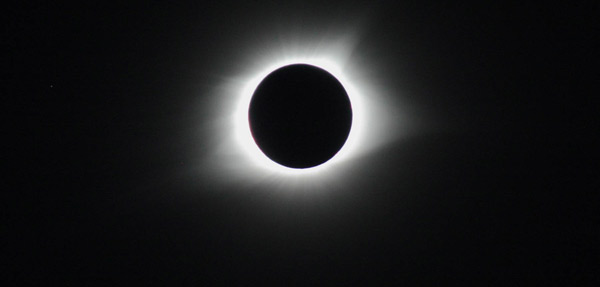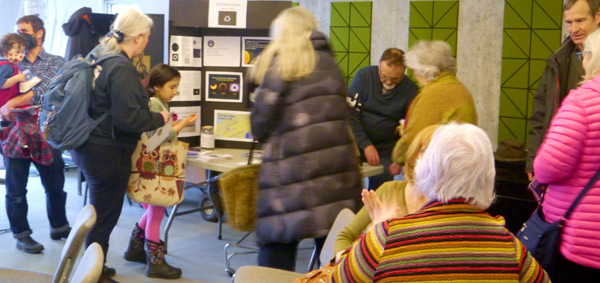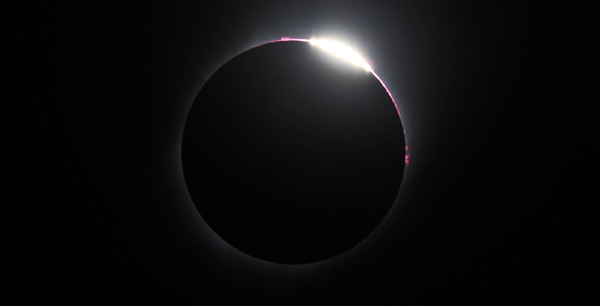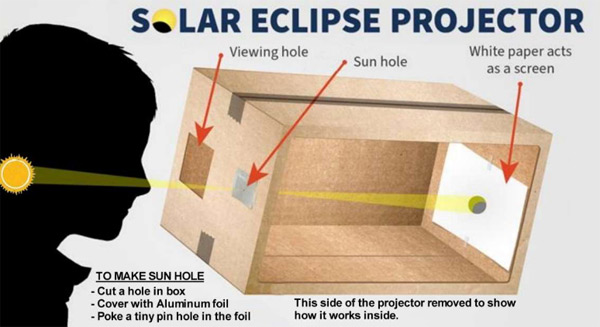County residents ‘totality’ interested in coming solar eclipse
Administrator | Mar 04, 2024 | Comments 0
By Sharon Harrison
It turns out there are a lot of people interested in learning about the upcoming total solar eclipse, so much so, that folks were turned away from a full house meeting, but quickly a second session was scheduled an hour later – again to full capacity at the Picton library.
The friendly folks with the Belleville Centre of the Royal Astronomical Society of Canada (RASC) are passionate about astronomy, knowledgeable in their field (or sky), and were happy to share what they know in a down-to-earth, easy-to-follow way, joyful the rest of us might just be interested in what for many of its members is a life-long interest, even when they call themselves amateur astronomers.
Several of those astronomers came to the Picton branch library flex space on Saturday to provide the public with a free session on some basics about what to expect as Prince Edward County is on the path to experience a once-a-lifetime total eclipse of the sun.
RASC member Don Town is a retired engineer and has been into astronomy for 25-30 years. He was the RASC national council representative for 18 years, and is now co-president of the Belleville centre.
Leading the special total solar eclipse presentation and slide show, which was followed by questions, Town explained what an eclipse is, what the big deal is, what to expect during the eclipse, how long it will last, why it is such a rare phenomenon, and eye safety.
The extraordinary event happens Monday, April 8, at precisely 3:20 p.m, and will last for some three minutes, in its total eclipse phase.
You don’t need a fancy or expensive telescope to view the eclipse, you can just stand there “with a good pair of glasses and you are good to go”, – but only special eclipse glasses and not regular sunglasses, prescription glasses, or any other kind of glasses.
“You don’t need your glasses during the three minutes of totality, when the moon is completely covering the sun, but that is the only time you don’t need them.”
Town said that quite often, lunar eclipses and solar eclipses go hand-in-hand.
“The orbit isn’t on the same plane as the earth’s sun orbit, it’s actually tipped up by five degrees, and there are only certain times when the moon is in position to block the light from the sun,” said Town. “That five degree inclination makes the difference.”
Lunar eclipses happen more often than solar eclipses, he said, because they are so much bigger than the moon that they cast a nice big shadow; the moon is a lot smaller, so it has a lot smaller shadow.
“In a solar eclipse, the moon is blocking the light hitting the earth, and the partial shadow, an umbra, isn’t even covering over the whole earth, it’s just a small band, and the total eclipse, the umbra, is going to have a solid shadow.”
WHAT ELSE IS THERE TO SEE?
Town also talked about how the “diamond ring” will also be visible during the eclipse as the moon starts to cover the face of the earth.
“It’s just a bit sunshine, it looks like a nice, bright diamond ring, and that sunlight gradually changes until it’s completely covered,” said Town, where he pointed out that just before it gets completely covered, some ridges will be seen.
“Those ridges are actually mountains on the moon, craters etc., and you will be able to see sunlight peeking between them, and then finally when the moon moves over, they will be completely in darkness, and that’s when you get into totality, and during totality you’ll see flares and stuff on the other side.”
Town explained that when the moon covers the sun, “you will see all this gas and stuff being ejected from the sun; you’ll see flares on the limb too”.
He noted that right now the sun is going through big cycles in terms of activity.
“Every 11 years it’s quiet and then it peaks up and we are near the peak, so there is a lot of stuff happening on the sun. A lot of sun spots, a lot of flares, corona mass ejections, and if you are up north, you can see a lot of northern lights, we will see a lot of junk coming off the sun.”
Along with mountains, sun spots, flares, junk and more during the eclipse, Town said it may be possible to see some planets and stars, and maybe even a comet.
“The comets that coming through is C12P Pons-Brooks (also called the Devil’s Comet) and it may be bright, but it may not be,” said Town. “If it is bright, we will be able to see it with the solar eclipse.”
During totality, when the moon is completely covering the sun, he said you will be able to see Venus, Jupiter and Pons-Brooks will be right near it in the south-west sky, and some other stars may also be visible with it.
ECLIPSE PATH
The path of the April 8 eclipse starts off in the South Pacific, goes through Mexico and Texas, and in Canada through the Niagara region, Ontario, and through the Atlantic provinces and exits up by Newfoundland. And the path is from west to east, the same way the moon is moving, and the shadow is falling.
He said, the closer you are to the centre line, the longer the eclipse (and totality) will be.
“The eclipse moves across; its slowest is about mid-section, when it’s over the Atlantic, because of the curvature of the earth, it’s moving along pretty quickly. When it’s moving over top of us, it will be going about 2,000 miles an hour, so that shadow is really clipping.”
Now, the partial eclipse part of the total eclipse does start earlier, at about 2:08 p.m. in this area, ending at around 4:33 p.m., and there may be some changes visible in the sky as it enters totality, then exits totality, but the big deal is the total eclipse part itself which will last just about three minutes.
RARITY
What’s amazingly special about this total eclipse of the sun is, it’s the first time it’s happened in southern Ontario in 400 years. And it won’t occur again for another 375 years.
The last total eclipse of the sun in this area was in 1349; the next one in this area is in 2399, “that’s 700 years between the last one and the next one, which is basically 10 lifetimes”.
He said there are usually two or three solar eclipses or partial annular eclipses every year somewhere on the earth, as he explained why we why don’t we get an eclipse every month.
“The earth going around the sun, the moon going around the earth, but the planes are different, their paths are different by about five-and-a-half degrees, roughly. So it’s only once a while when those line up and we get either a solar or a lunar eclipse.”
WHAT TO EXPECT
During the eclipse things will start to get darker.
“For the first little bit of the eclipse you won’t notice it if you use your glasses and you look up and see a little bite out of the sun, but it doesn’t look that much darker because your eyes are going to adjust to it.”
As it progresses, the shadows start to get sharper and you will be able to see the moon’s shadow approaching, coming up to us from the south-west, so you can see the sky actually getting darker, he explained.
How long totality will last, depends on where you are, where the further south you are, the longer it will be, and the further north you are, its starts to peter out.
Its path means Prince Edward County will be in totality, meaning the sun will be totally covered, by the moon. Most of the rest of North and Central America will only see a partial eclipse, but the County hits the jackpot this time around, and the farther south you are, the better the viewing, or rather the longer the viewing time.
The total solar eclipse can be seen anywhere in the County: In Picton, total eclipse of the sun will last 3 minutes, 2 seconds; at Point Petre, 3 minutes. 24 seconds.
“We are pretty lucky to be here in the County,” said Town, “And the timing specifically, again where you live depends on when the partial begins, when totality begins, and when totality ends. By 4:30 p.m. it’s all done.”
As totality ends, everything happens again in reverse.
“You will see Baily’s beads (diamond ring) the same thing in reverse, the moon mountains pulling back and will you see some sunlight peeking through the mountains, and you will get into the diamond ring effect again,” said Town. “Then we are back into the partial eclipse, and another hour or so later, we are done.”
EYE SAFETY
While a total eclipse of the sun is an exciting event, even for non-astronomy folks, there is a serious side to this wondrous astronomical event, because viewing a solar eclipse can be dangerous for the eyes where the sun can penetrate and burn the retina causing severe damage (the eye has no pain receptors, so staring at the sun doesn’t come with pain, just terrible, and permanent, eye damage).
Town spoke about the importance eye safety when viewing the eclipse, saying it’s too easy to damage eyes.
“I do want to stress the eye safety as it’s too easy to damage your eyes, especially kids. They are going to be having a PA day, so they’re not going to be in school and supervised.”
He said parents and guardians should make sure if the kids are out watching the eclipse, that they are properly protected.
“Two bucks is cheap. Eye sight is just too precious.”
Ophthalmologists call it eclipse blindness, or burns on your retinas caused by high-intensity visible light; the radiation literally cooks your eyes, but the retina has no pain sensors so you won’t know what’s happened.
“It’s easy and cheap to prevent eye damage from the eclipse with inexpensive cardboard sunglasses designed specifically to allow you to look at the sun without harming your eyes.”
Even at the beginning stages of the eclipse when the moon blocks out just a portion of the sun’s light, you can’t look directly at it, even for brief moments without these specialty sunglasses, he said.
If you are purchasing the glasses, the experts say to make sure they are the real thing and are ISO certified (ISO 12312-2) and suggest trying them on as you shouldn’t be able to see anything through them, except very bright lights, and the sun.
RASC were selling certified eclipse glasses at the event for $2, where folks could also pick-up information materials.
“Your eye’s lens acts like a magnifying glass, so you are focussing a light and literally burning the retina, with no pain receptors you wouldn’t feel your retina sizzle. What happens is you end up with a spot where that burn is and that is eclipse blindness, or solar retinopathy.”
While the blind spot in your vision can heal over time, you really can’t do much after the damage has occurred, and they warn that regular sunglasses won’t cut it.
“Just make sure you put them on before you look up, as the eclipse glasses filter out most of the sun,” said Town.
Because the day was changed to a PA Day due to the eclipse, Town said he is concerned that “you’ve got a bunch of kids running around looking up at the sun with no parents around”.
“They should have kept the kids in school 45 minutes longer and they could have had a really good education at the classes there, properly supervised, with glasses, and it could have been a real science project.”
The only safe time to look at the eclipse is when it is in totality, for those three or so minutes. Don’t look at it during the partial stages, as that’s when you can damage your eye (if not wearing eclipse glasses).
However, it is safe to go about your regular day, to be outside doing something (such as gardening, driving, etc.), even during totality (and without special eye protection), providing you aren’t looking up at the sun.
It was also suggested that folks avoid the temptation of photographing the eclipse, unless they have appropriate filters for their cameras (including cell phone cameras), or know exactly what they are doing. It’s best to seek professional advice as not only can the sun burn your eyes, but it’s likely to burn and damage the camera too. Town advises to simply enjoy watching the eclipse (wearing eclipse glasses), and to leave the photography to the experts.
ABOUT USING TELESCOPES OR BINOCULARS
A short film clip was a powerful way to show the dangers of using a telescope or binoculars during the eclipse, if you don’t know what you are doing.
You shouldn’t put on your eclipse sunglasses and look through a telescope (or binoculars) that are unfiltered. When sunlight comes right through the eyepiece, it is burning a hole right through and that’s how powerful a telescope is, and that could be your eye.
Town said anyone can make a pretty cheap solar filter using a cereal box or cylindrical shape, by cutting a hole in the bottom, and another hole in the top portion, covering with aluminum foil where the image will be projected through the pin hole onto a sheet of paper placed inside on one end which will allow you to look at the sun safely, and is a cheap way of doing it, so you are not looking at the sun directly. (This would make a great kids’ project – Google for full instructions).
The sun’s energy is about a kilowatt per square metre, a 1,000 watts for every square metre. The energy required to damage your eyes is about three watts per square metre. So 300 times the power of the sun is enough to cause permanent eye damage.
WEATHER
Here’s the bad news.
While the total eclipse is guaranteed, the weather is not.
“We are in the right place, but we are in the wrong place,” said Town. Chances are, based on 20-year data, we will have a 65 per cent chance of clouds on April 8.
“We may get clouded out, but we may not, and if it’s just light cumulus cloud they typically just dissipate as the partial eclipse goes into totality, so the clouds may dissipate if it’s the light fluffy ones.”
He said if it is cloudy, it will still get dark outside, but you won’t be able to see much.
To learn more about viewing the total solar eclipse safely, the Royal Astronomical Society of Canada, Belleville Centre has some useful information on its website at rascbelleville.ca
Further RASC information sessions are scheduled for:
-Quinte West Public Library Tuesday, March 19 at 9:30 and 10:15 a.m. at 7 Creswell Drive, Trenton
-Community Booth at the Quinte Mall Saturday, March 23 from 9:30 a.m. to 4:30 p.m. at 390 N Front St, Belleville
– Belleville Library, Saturday March 30 at 10:30 a.m. at 254 Pinnacle St. Belleville
Also, more information at timeanddate.com/eclipse/solar/2024-April-8
Filed Under: Featured Articles • News from Everywhere Else
About the Author:



































